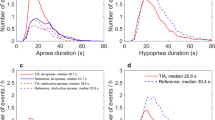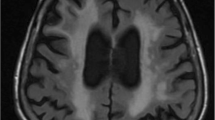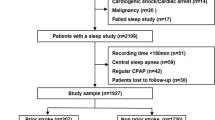Abstract
Since sleep apnea (SA) and stroke have many shared risk factors an independent contribution of SA to the overall risk of stroke is not easily proven and has been questioned recently. To contribute to this controversy, we analysed the frequency of SA in groups of patients with first and recurring ischemic stroke. We prospectively studied 102 patients admitted to our stroke unit. The prevalence of vascular risk factors and a history of previous stroke were recorded. All patients received cardio–respiratory polygraphy during the first 72 hours after admission. CT and MRI scans were evaluated for the location of the acute stroke and the presence of older vascular lesions. Thirty–four women and 68 men with a mean age of 64.5 ± 13.7 years were included in the study. Cerebral lesions attributable to a previous stroke were identified in 25 patients, of whom 19 reported to have suffered a stroke before. Patients with stroke recurrence had a higher mean apnea–hypopnea index (AHI) (26.6/h vs. 15.1/h, p<0.05) and more often presented with a sleep apnea syndrome (SA) defined by an AHI ≥ 10/h (80 vs. 52%, p < 0.05) than patients with first ever stroke. Logistic regression analysis including the variables "age", "gender", "cumulative risk factors", "AHI ≥ 10/h", and "diabetes" identified diabetes (Odd’s ratio [OR] = 4.5) and AHI ≥ 10/h (OR = 3.5) as independent risk–factors for stroke recurrence. According to our results SA is an independent risk factor for stroke recurrence. We therefore advocate routine sleep–apnea screening in all patients having suffered an ischemic stroke.
Similar content being viewed by others
References
Adams HP, Bendixen BH, Kappelle LJ, Biller J, Love BB, Gordon DL, Marsh EE (1993) Classification of subtype of acute ischemic stroke. Definitions for use in a multicenter clinical trial. TOAST. Trial of Org 10172 in Acute Stroke Treatment. Stroke 24:35–41
Ancoli–Israel S, Klauber MR, Stepnowsky C, Estline E, Chinn A, Fell R (1995) Sleep–disordered breathing in African–American elderly. Am J Respir Crit Care Med 152:1946–1949
Bassetti C, Aldrich MS (1999) Sleep apnea in acute cerebrovascular diseases: final report on 128 patients. Sleep 22:217–223
Bassetti C, Aldrich MS, Chervin RD, Quint D (1996) Sleep apnea in patients with transient ischemic attacks and stroke. A prospective study of 59 patients. Neurology 47:1167–1173
Bassetti C, Aldrich MS, Quint D (1997) Sleep–disordered breathing in patients with acute supra– and infratentorial strokes. A prospective study of 39 patients. Stroke 28:1765–1772
Bobinsky G, Miller M, Ault K, Husband P, Mitchell J (1995) Spontaneous platelet activation and aggregation during obstructive sleep apnea and its response to therapy. Chest 108:625–630
Brott T, Adams HP, Olinger CP, Marler JR, Barsan WG, Biller J, Spilker J, Holleran R, Eberle R, Hertzberg V (1989) Measurements of acute cerebral infarction: a clinical examination scale. Stroke 20:864–870
Davies DP, Oates J, Close P, Rogers H, James OFW, Gibson GJ (1997) Is obstructive sleep apnoea associated with stroke? Eur Respir J 10(Suppl):135
Dealberto MJ, Ferber C, Garma L, Lemoine P, Alperovitch A (1994) Factors related to sleep apnea syndrome in sleep clinic patients. Chest 105:1753–1758
Diomedi M, Placidi F, Cupini LM, Bernardi G, Silvestrini M (1998) Cerebral hemodynamic changes in sleep apnea syndrome and effect of continuous positive airway pressure treatment. Neurology 51:1051–1056
Dyken ME, Somers VK, Yamada T, Ren Z, Zimmermann B (1996) Investigating the relationship between stroke and obstructive sleep apnea. Stroke 27:401–407
Good DC, Henkle JQ, Gelber D, Welsh J, Verhulst S (1996) Sleep–disordered breathing and poor functional outcome after stroke. Stroke 27:252–259
Harbison J, Ford GA, James OFW, Gibson GJ (2002) Sleep–disordered breathing following acute stroke. Q J Med 95:741–747
Harbison JA, Gibson GJ (2000) Snoring, sleep apnoea and stroke: chicken or scrambled egg? Q J Med 93:647–654
Harbison JA, Gibson GJ, Birchall D, Zammit–Maempel I, Ford GA (2003) White matter disease and sleep–disordered breathing after acute stroke. Neurology 61:959–963
Harbison JA, O’Reilly P, McNicholas WT (2000) Cardiac rhythm disturbances in the obstructive sleep apnea syndrome: effects of nasal continuous positive airway pressure therapy. Chest 118:591–595
Iranzano A, Santamaria J, Berenguer J, Sanchez M, Chamorro A (2002) Prevalence and clinical importance of sleep apnea in the first night after cerebral infarction. Neurology 58:911–916
Levinson PD, Mc Garvey ST, Carlisle CC, Eveloff SE, Herbert PN, Millman RP (1993) Adiposity and cardiovascular risk factors in men with obstructive sleep apnea. Chest 103:1336–1342
McArdle N, Riha RL, Vennelle M, Coleman EL, Dennis MS, Warlow CP, Douglas NJ (2003) Sleep–disordered breathing as a risk factor for cerebrovascular disease. Stroke 34: 2916–2921
Mohensin V, Valor R (1995) Sleep apnea in patients with hemispheric stroke. Arch Phys Med Rehabil 76:71–76
Neau JP, Meurice JC, Paquereau J, Chavagnat JJ, Ingrand P, Gil R (1995) Habitual snoring as risk factor for brain infarction. Acta Neurol Scand 92:63–68
Nieto FJ, Young TB, Lind BK, Shahar E, Samet JM, Redline S, D’Agostino RB, Newman AB, Lebowitz MD, Pickering TG (2000) Association of sleep–disordered breathing, sleep apnea, and hypertension in a large communitybased study. JAMA 283:1829–1836
Parra O, Arboix A, Bechich S, Garcia– Eroles L, Montserrat JM, Lopez JA, Ballester E, Guerra JM, Sopena JJ (2000) Time course of sleep–related breathing disorders in first–ever stroke or transient ischemic attack. Am J Respir Crit Care Med 16:375–380
Peppard PE, Young T, Palta M, Skatrud J (2000) Prospective study of the association between sleep–disordered breathing and hypertension. N Engl J Med 342:378–384
Shahar E, Whitney CW, Redline S, Lee ET, Newman AB, Nieto FJ, O’Connor GT, Boland LL, Schwartz JE, Samet JM (2001) Sleep–disordered breathing and cardiovascular disease. Am J Respir Crit Care Med 163:19–25
Turkington PM, Allgar V, Bamford J, Wanklyn P, Elliot MW (2004) Effect of upper airway obstruction in acute stroke on functional outcome at 6 months. Thorax 59:367–371
Turkington PM, Bamford J, Wanklyn P, Elliott MW (2002) Prevalence and predictors of upper airway obstruction in the first 24 hours after acute stroke. Stroke 33:2037–2042
Wade DT (1992) Rankin scale. In: Wade DT (ed) Measurement in neurological rehabilitation. Oxford University Press: Oxford, pp 238–239
Wessendorf TE, Thilmann AF, Wang YM, Schreiber A, Konietzko N, Teschler H (2000) Fibrinogen levels and obstructive sleep apnea in ischemic stroke. Am J Respir Crit Care Med 162:2039–2042
Young T, Palta M, Dempsey J, Skatrud J, Weber S, Badr S (1993) The occurrence of sleep–disordered breathing among middle–aged adults. N Engl J Med 328: 1230–1235
Author information
Authors and Affiliations
Corresponding author
Additional information
The first two authors contributed equally to this work.
Rights and permissions
About this article
Cite this article
Dziewas, R., Humpert, M., Hopmann, B. et al. Increased prevalence of sleep apnea in patients with recurring ischemic stroke compared with first stroke victims. J Neurol 252, 1394–1398 (2005). https://doi.org/10.1007/s00415-005-0888-7
Received:
Revised:
Accepted:
Published:
Issue Date:
DOI: https://doi.org/10.1007/s00415-005-0888-7




